I was walking past a small ornamental garden in Sheung Shui back in November when I noticed this:
Believe it or not, each of the ‘sticks’ making up these ‘vases’ is an individual living plant!
The next photo is a view of the Kam Tin River, looking downstream. The elevated railway is part of what was once known as the West Rail Line. There used to be a cross-platform connection with the East Rail Line, which inter alia runs through Fanling, at the Hung Hom terminus. However, the Ma On Shan Line, formerly a mere branch line connecting the new town of Ma On Shan to the network, has now been connected to the former West Rail Line, which terminates in the most westerly of the new towns in the New Territories, Tuen Mun. Unsurprisingly, the West Rail Line has now been renamed the Tuen Ma Line:
This is a view of the same stretch of river, looking upstream:
The second photo was taken on a subsequent occasion. When we’re cycling through the area, the vantage point from which this photo was taken is reached first.
I photographed these yellow pom-pom flowers in a small private garden on the road out of our village towards the river. They were gone within a few days:
I’m not sure where I took the next photo, but I think it’s somewhere near the Prince of Wales Hospital in Shatin, where I’ve been an outpatient recently. It shows a housing estate that is under construction, with a tower crane on each block:
I took the next photo, which shows the minibus station next to Fanling station, entirely because of the tiny crescent moon. The left-hand of the two empty bays in the centre of the photo is where we would catch a minibus to our village:
In the past, I’ve devoted entire posts to displays 0f bougainvillea (Bougainvillea Boogie, Bougainvillea Boogie #2, Bougainvillea Boogie #3), but I don’t see many new examples of this impressive show of colour nowadays, so I’ve decided to include the ones that I’ve seen during the past few months in this collection. This one can be seen in Kwu Tung North, a couple of kilometres east of Fanling:
I can’t comment on the traditional Chinese building in the background, because it’s not possible to gain access to take a closer look.
A lot of trees in Hong Kong have roots that can be seen above the surface, but what drew my attention to the tree in my next photo was the way the brick paving has shaped the direction the roots have grown. This example, in Luen Wo Hui, is one of a line of trees of the same species, all of which have had their root systems modified, albeit less dramatically, by the paving, which follows the single basket-weave arrangement that is almost ubiquitous in Fanling:
I don’t think I need to explain why I took the next photo. Jockey Club Road is probably the busiest road in Fanling, and most of the street signs are spelled correctly, but I’ve seen at least one other sign where the name has been misspelled like this:
Large leaves like this are ideal for collecting rainwater, although it probably isn’t safe to drink:
This is another view of the minibus station next to Fanling station. This photo was taken in the late morning of 1st January, which was a public holiday. The inordinately long queue is for a minibus to Hok Tau in the Pat Sin Leng Country Park, which is a popular destination for day trippers from the city for hiking and barbecues:
The queue is so long that it extends into the next bay, which would make it awkward to catch a minibus to our village because we would have to push through the crowd.
I’ve no idea why the occupant of the house in the next photo has decided to hang up hundreds of empty bottles, although I conjecture that it may create an unusual lighting effect inside (this wall faces west):
The road past this house, which is located west of Fanling, is a cul de sac, so it carries almost no motor traffic, which makes it ideal for cycling (it’s a dead end only for larger vehicles).
Three black-winged stilts (‘red legs’) in the Kam Tin River:
Almost all the examples of bougainvillea that I see are cultivated, with the colour displays hanging over people’s boundary walls/fences, but this one, on a little-known road on the southern outskirts of Fanling, is completely wild:
I probably cycled past this truck, parked alongside the unnamed road linking Kwu Tung North and Ha Shan Kai Wat, quite a few times before deciding to take a photo:
There! You have it on good authority. Paint is dead! I didn’t realize it was ever alive.
(storm drain I photographed these two large dolls on the other side of a nullah (‘storm drain’) that runs alongside Hok Tau country trail #1. The one on the left is meant to be the front half of a dancing lion:
Continued in Part 3…


















Never get tired to notice interesting things around and will keep watching!
ReplyDeleteAnd there’s more to come!
Delete